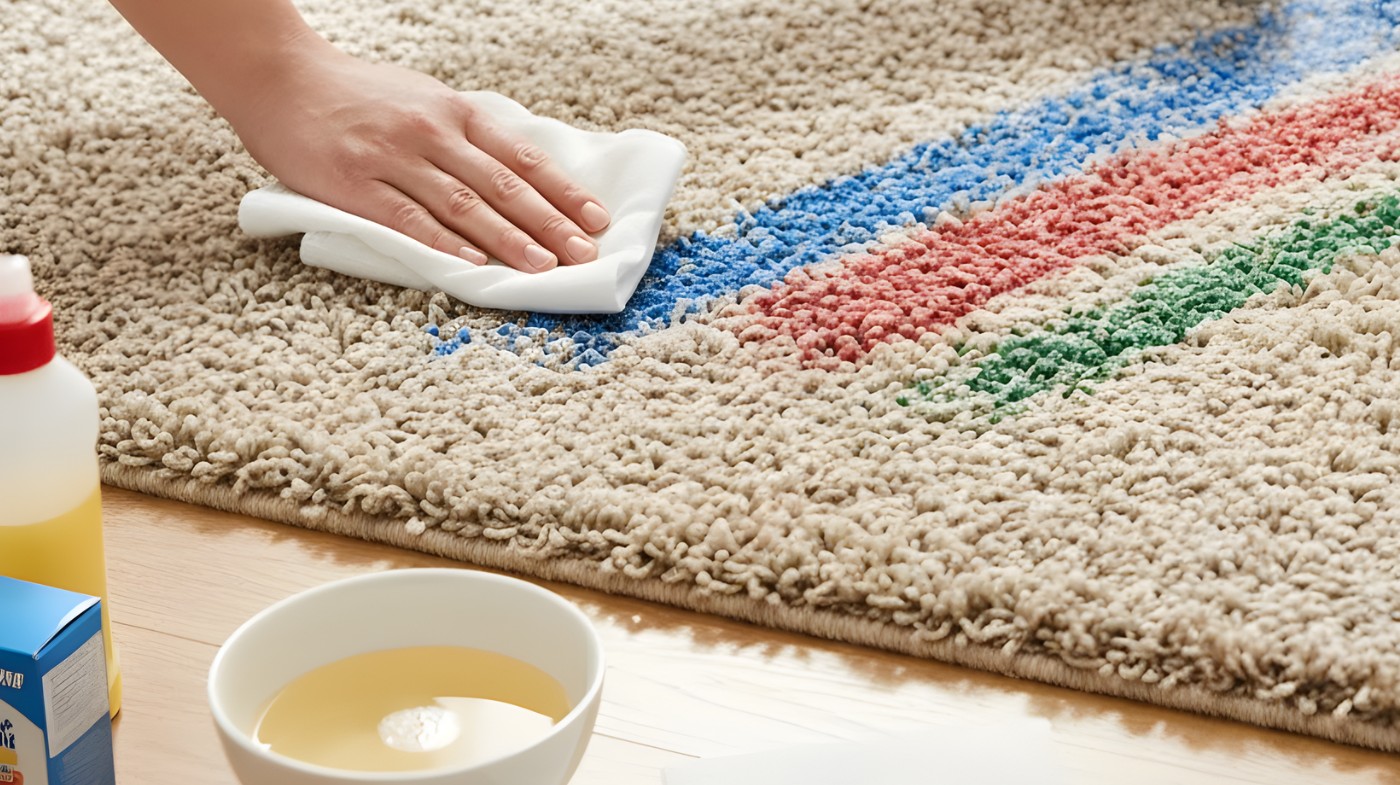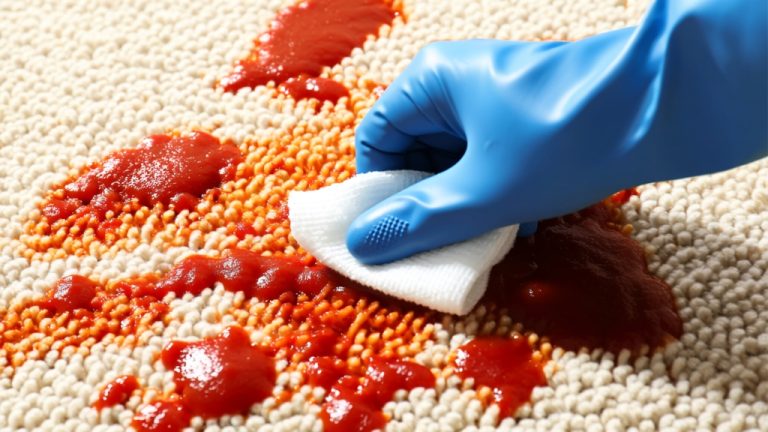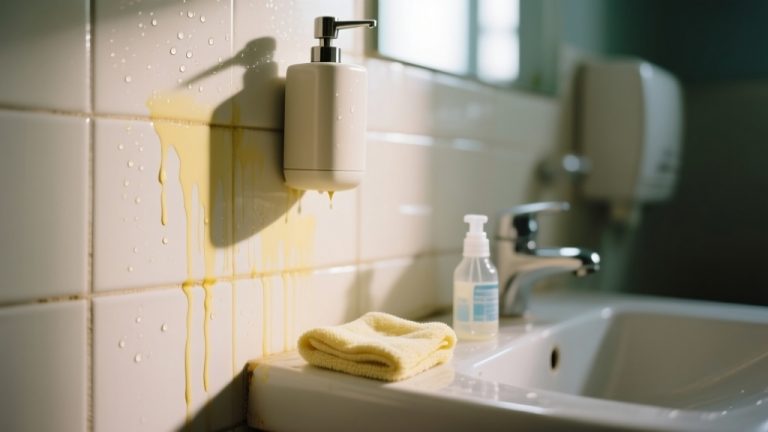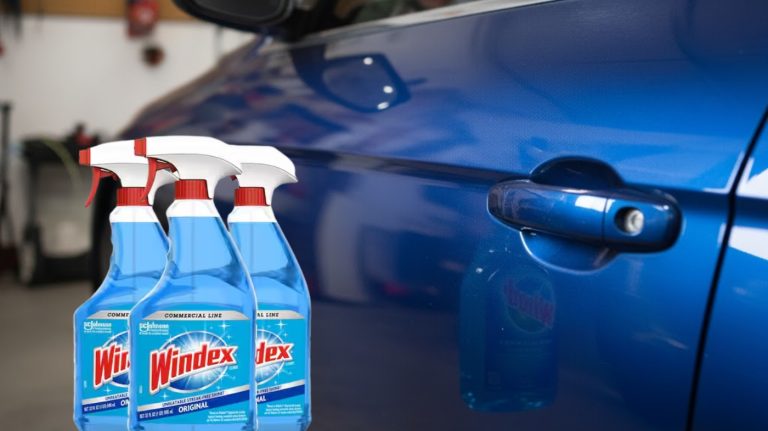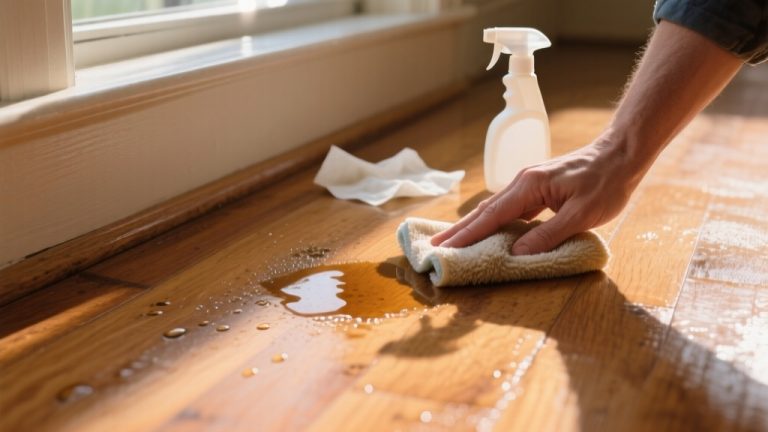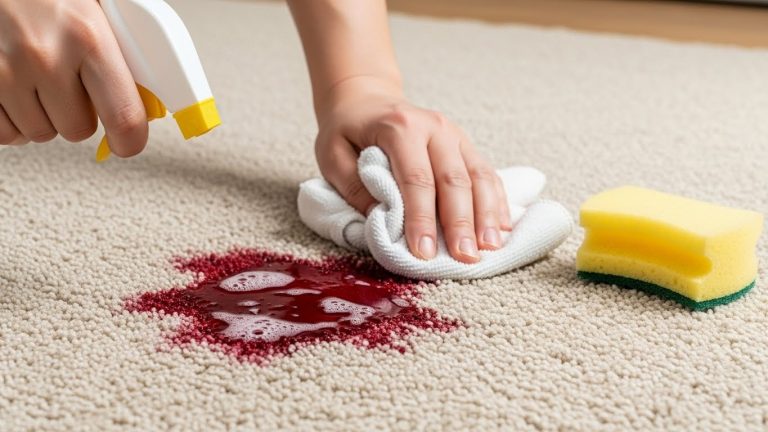How to Get Crayon Out of Carpet? Proven Cleaning Tips
To get crayon out of carpet, first harden the wax with ice cubes. Then gently scrape off as much as possible with a dull-edged tool.
Next, apply a baking soda paste over the stain and let it sit to lift residue. Blot with a cloth soaked in a dish soap and warm water solution, rinse with plain water, then blot dry.
For stubborn marks, a vinegar solution helps break down wax. Explore further for professional tips and advanced methods.
Key Takeaways
- Harden crayon wax with ice cubes, then gently scrape off excess with a dull-edged tool to avoid fiber damage.
- Apply a baking soda paste on a damp carpet stain, let it sit at least 15 minutes, then vacuum thoroughly.
- Blot the stain with a cloth soaked in dish soap and warm water solution, avoiding rubbing to protect carpet fibers.
- Use a mixture of one part white vinegar to two parts water, blotting and reapplying until crayon residue lifts fully.
- Test cleaning solutions on a hidden carpet area first and seek professional help if stains persist or carpet is delicate.
Preparing the Carpet for Crayon Removal
Before you start removing crayon from your carpet, carefully assess the stained area by inspecting the size, depth, and color of the marks.
Identify the carpet fiber type and test colorfastness in a hidden spot to avoid discoloration. Document the stain’s appearance for comparison post-treatment.
Next, gather necessary supplies: a butter knife or dull-edged tool for scraping, clean white cloths or paper towels for blotting, ice cubes in a plastic bag for hardening wax, and a vacuum cleaner for debris removal. Always test cleaning solutions on discreet carpet sections to prevent discoloration to ensure safe treatment. It is also important to ensure the cleaning area is well-ventilated to reduce the risk of overheating hazards.
Prepare the cleaning environment by clearing furniture away, ensuring proper ventilation, and placing protective towels to contain spills.
Review safety guidelines, confirm cleaning methods suit your carpet type, and keep pets and children out of the area to maintain safety throughout the process.
Using Dish Soap and Warm Water
Once you’ve prepped the carpet and gathered your supplies, using dish soap mixed with warm water provides an effective method to break down crayon wax.
Combine a few drops of dish soap, preferably Blue Dawn or a mild alternative, with one cup of warm water. Ensure the solution isn’t overly concentrated to prevent residue. Blue Dawn’s surfactants effectively cut through grease and wax, making it especially useful for crayon stains.
Apply the solution gently to the stain using a clean cloth, and blot without rubbing to avoid spreading. It is important to use non-abrasive cleaning methods to protect carpet fibers during stain removal.
After blotting, rinse the area with clean water to eliminate soap remnants.
Repeat this process until the crayon is fully removed.
Always perform a spot test beforehand and avoid over-saturating the carpet to prevent fiber damage or mold growth.
Allow the carpet to air dry naturally after treatment.
Applying a Vinegar Solution
Alright, let’s get started on tackling that crayon stain! First, you’ll want to mix one part distilled white vinegar with two parts water. Just give it a gentle stir to make sure everything blends nicely.
Now, grab a clean, white cloth and apply the solution directly onto the crayon stain. Be sure to blot gently; we don’t want to push the wax any deeper into the fabric. Keep blotting until you don’t see any more crayon transferring to the cloth. Using a soft, lint-free cloth helps prevent embedding the stain further.
It might help to let the solution sit for a moment to really break down any stubborn residue. Vinegar solution can help break down wax and facilitate stain removal.
Mixing Vinegar Solution
Although vinegar’s acidity is key to breaking down crayon wax, you’ll need to dilute it properly to protect your carpet fibers.
Prepare a solution by mixing one part white vinegar with two parts water. This ratio balances effectiveness with safety, as undiluted vinegar’s acetic acid can damage fibers and emit strong odors.
Always use white vinegar for its mild acetic acid content, which dissolves wax oils and neutralizes pigments.
For ideal results, prepare a fresh batch for each cleaning session to maintain potency.
If you must store leftovers, seal and refrigerate them, but fresh mixtures are preferred.
Before full use, test the solution on an inconspicuous carpet area to check for adverse reactions.
Applying and Blotting
When applying the vinegar solution, you should gently blot the crayon stain with a clean, white cloth dampened with the mixture. Take care not to saturate the carpet. Because crayon contains both wax and pigment, addressing both components is essential for effective removal, so the vinegar helps break down residues. Start blotting from the stain’s outer edge, working inward to prevent halos.
Use a pressing and lifting motion to absorb wax without rubbing, which risks fiber damage. Rotate or replace the cloth frequently to avoid re-depositing residue. Proper rinsing and quick drying of carpets prevent chemical penetration into padding, which can saturate padding and cause mold or odors.
Reapply the vinegar solution as needed, blotting between applications until no more wax transfers to the cloth.
After removal, rinse the area with plain water and blot dry thoroughly to eliminate vinegar residue and prevent fiber degradation.
Allow the carpet to air dry completely before vacuuming to restore fiber texture and remove loosened particles.
Treating Stains With Baking Soda Paste
To whip up a baking soda paste, you’ll want to combine baking soda with just enough water to achieve a nice, thick consistency that you can easily spread.
Once you’ve got that paste ready, go ahead and apply it evenly over the crayon stain. Just make sure the area is damp, but not completely soaked. Using gentle agitation can help the paste penetrate the carpet fibers for better stain removal.
Now, here’s the important part: let that paste sit for several hours. This waiting period really helps with absorbing and lifting the stain. Leaving the baking soda paste on the carpet for an extended time, such as overnight, can significantly improve stain removal effectiveness extended sitting.
Afterward, you can vacuum it up, and you should see a noticeable difference. Regular maintenance and cleaning can prevent stains from setting permanently, similar to preventative measures used in other cleaning scenarios.
Baking Soda Paste Preparation
Since baking soda’s abrasive properties make it effective at neutralizing odors and lifting stains, you’ll want to prepare a paste by mixing it with just enough water to achieve a spreadable yet thick consistency.
Use a small amount of water to avoid overwetting, which can damage carpet fibers. The paste should adhere well to the stained area without being runny, ensuring targeted treatment.
Avoid excess baking soda to prevent residues. Before applying, test a hidden carpet section for color fastness to prevent discoloration.
Mix baking soda and water gradually for precise texture control. Ensure paste thickness allows even spreading on stains.
Use minimal water to protect carpet integrity. Conduct a spot test for color-fastness. Prepare only the amount needed to maintain paste effectiveness.
Application Techniques
Although baking soda paste requires time to work effectively, applying it correctly guarantees ideal stain neutralization and lifting.
First, apply a generous layer over the fresh crayon stain, ensuring full coverage of affected fibers. Let the paste sit for at least 15 minutes; for tougher or greasy stains, extend this to overnight. Baking soda is most effective when allowed to sit for several hours, as this improves neutralization and stain removal. To avoid long-term damage, it is important to vacuum thoroughly after treatment to remove all residue and particles.
Avoid rubbing at this stage to prevent fiber damage. Multiple applications might be necessary for heavy residues. Always test on a hidden carpet section to confirm no adverse effects.
After the designated time, vacuum thoroughly to remove the dried paste and lifted particles. Remember, baking soda is mildly abrasive and alkaline, neutralizing acidic crayon components.
Patience and proper application maximize stain removal while preserving carpet integrity.
Stain Removal Process
When you treat a crayon stain with baking soda paste, you’ll start by applying the prepared paste directly onto the affected carpet fibers, ensuring full saturation. This allows the mild alkali and abrasive properties to break down and lift the wax and pigment effectively.
Baking soda’s mild alkali nature helps to break down dirt and grease, making it especially effective for wax-based stains like crayon. For best results, ensure the area is well-ventilated to minimize any potential irritation from airborne particles.
After application, leave the paste undisturbed for at least 15 minutes to several hours, depending on stain severity. Once dry, gently loosen the residue with a soft brush, then vacuum thoroughly. Repeat if necessary.
Mix baking soda with water to form a thick paste. Avoid vinegar alone to maintain cleaning efficacy. Allow paste to dry fully for maximum absorption. Use gentle brushing to protect carpet fibers.
Test a hidden area for color-fastness before treatment. This step helps avoid damage, as surface compatibility is crucial for effective and safe stain removal.
Removing Crayon With WD-40
If scraping, heat, freezing, or soap don’t fully remove crayon residue, you can turn to WD-40 to break down the waxy components effectively.
Begin by spraying WD-40 directly onto the crayon stain, ensuring full coverage. Let it penetrate for several minutes to dissolve the wax. Using a product with deep stain removal capabilities can improve results on stubborn marks.
WD-40 is effective for removing crayon from wallpaper, so it can be trusted for use on carpet stains as well.
Use a clean white cloth to dab the area with a rolling motion, rotating the cloth as it absorbs residue. Repeat spraying and blotting until the stain no longer transfers.
Afterward, clean the treated area thoroughly with mild dish soap and water to remove WD-40 and residual wax.
Blot dry with a towel and allow the carpet to air dry completely. Test WD-40 on an inconspicuous spot before use, and ensure proper ventilation during application.
When to Seek Professional Carpet Cleaning Services
Deciding to hire professional carpet cleaning services becomes necessary once you’ve exhausted home removal techniques and still face persistent crayon stains or carpet damage risks.
Professionals use advanced steam cleaning that penetrates fibers deeply, removing wax and pigment residues without harming carpet integrity. These services typically cost between $40 to $90+ per room, reflecting the thoroughness and expertise involved. Many professionals also utilize specialized attachments to enhance stain removal effectiveness.
Consider professional help if:
- Crayon stains resist repeated home cleaning attempts
- Wax has deeply embedded in dense or thick carpet fibers
- Additional old or tough stains coexist with crayon marks
- Carpet material is delicate or antique requiring specialized care
- Prior DIY efforts worsened the stain or damaged fibers
Delaying professional cleaning risks permanent discoloration, fiber damage, and odor development.
Professionals also provide protective treatments and ensure compliance with carpet warranty conditions, optimizing both stain removal efficacy and carpet longevity.
Frequently Asked Questions
Can Crayon Wax Damage the Carpet Fibers Permanently?
Crayon wax itself rarely causes permanent damage to carpet fibers since it mainly coats rather than chemically alters them.
However, if you use harsh scrubbing, aggressive solvents, or excessive heat during removal, you risk fiber abrasion, backing damage, or discoloration.
To prevent permanent harm, you should apply gentle methods like blotting, careful heating with a towel, and mild detergents.
Always test cleaning agents on a hidden area first to avoid unintended fiber or dye damage.
Is It Safe to Use Heat to Melt and Remove Crayon Wax?
You can use heat to melt and remove crayon wax, but you must be cautious.
Always set your iron to low heat and place a paper towel between it and the carpet to absorb wax safely.
If you have a nylon carpet, avoid high heat to prevent fiber melting.
Using a hair dryer offers gentler heat control.
Test your method on a hidden spot first to verify no damage occurs before proceeding.
How Long Should I Wait Before Cleaning a Fresh Crayon Stain?
You should start cleaning a fresh crayon stain immediately to prevent it from setting. Don’t wait; act quickly by scraping off excess wax gently, then apply a cleaning solution.
If you delay, the wax can harden and embed deeper into carpet fibers, making removal harder. Rapid intervention improves effectiveness and reduces stain persistence.
Always test cleaning agents on a hidden spot before applying to the stain to avoid damage.
Are There Any Natural Alternatives to Commercial Cleaning Products?
Yes, you can use natural alternatives like a mixture of distilled white vinegar and mild dish soap diluted in water for effective cleaning.
Baking soda absorbs odors and can help lift stains when combined with gentle scrubbing.
For sanitizing, a 3% hydrogen peroxide solution works well.
Plant-based enzyme cleaners, such as Puracy’s formula, break down organic stains naturally.
These options reduce chemical exposure and are safer for pets and allergies.
Can Crayon Removal Methods Affect Carpet Color or Texture?
Crayon removal methods can absolutely transform your carpet’s color and texture, sometimes as dramatically as a tornado hitting a calm town.
You need to use gentle cleaning agents and avoid harsh chemicals to prevent color fading or bleeding.
Over-scrubbing may damage fibers, causing pilling or roughness.
Always spot test solutions and avoid over-saturation to preserve carpet integrity.
Proper rinsing and drying also prevent moisture damage, keeping your carpet looking fresh and intact.
Keep Your Carpet Spotless: Master Crayon Removal Forever
Now that you’ve armed yourself with precise techniques, from gentle dish soap washes to the targeted power of WD-40, you can methodically erase crayon’s stubborn marks from your carpet.
Like a skilled craftsman refining a masterpiece, your careful application of these solutions will restore your carpet’s original canvas.
Should the stain prove relentless, don’t hesitate to call in professional reinforcements. This will ensure your carpet’s vibrant integrity remains untouched by time or accident.

